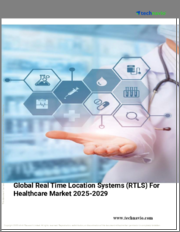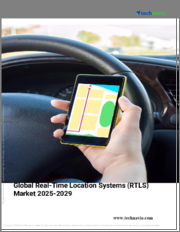
|
시장보고서
상품코드
1610826
실시간 위치추적 시스템 시장 규모, 점유율, 성장 분석 : 제공별, 기술별, 용도별, 산업별, 지역별 - 산업 예측(2024-2031년)Real-time Location Systems Market Size, Share, Growth Analysis, By offering, By Technology, By Application, By Industry, By Region -Industry Forecast 2024-2031 |
||||||
실시간 위치추적 시스템 세계 시장 규모는 2022년 52억 달러로 평가되며, 2023년 65억 3,000만 달러에서 2031년 320억 달러로 성장하여 예측 기간(2024-2031년) 동안 25.5%의 CAGR로 성장할 것으로 예상됩니다.
혁신적인 자산 관리 솔루션에 대한 수요가 전 세계적으로 급증할 것으로 예상되며, 향후 몇 년 동안 실시간 위치추적 시스템(RTLS)의 채택이 증가할 것으로 예상됩니다. 특히 헬스케어 분야는 RTLS에 대한 의존도가 높아지고 있어 시장 확대에 크게 기여할 것으로 예상됩니다. 또한, 운영을 최적화하기 위해 공급망 가시성을 강화해야 하는 필요성이 이러한 시스템의 보급을 더욱 촉진하고 있습니다. 연결성 향상과 IoT 기술의 확산은 RTLS 제공업체에게 새로운 기회를 가져다 줄 것입니다. 그러나 통합의 복잡성, 환경적 제약, 숙련된 인력 부족 등의 문제가 성장을 저해할 수 있습니다. 또한, RTLS 구현을 의무화하는 규제가 강화됨에 따라 시장의 잠재력이 높아져 향후 유망한 투자 분야가 될 가능성이 높습니다.
목차
소개
- 조사 목적
- 조사 범위
- 정의
조사 방법
- 정보 조달
- 2차 데이터와 1차 데이터 방법
- 시장 규모 예측
- 시장 가정과 제한
주요 요약
- 세계 시장 전망
- 공급과 수요 동향 분석
- 부문별 기회 분석
시장 역학과 전망
- 시장 개요
- 시장 규모
- 시장 역학
- 성장 촉진요인과 기회
- 성장 억제요인과 과제
- Porters 분석과 영향
- 경쟁 기업 간의 경쟁 관계
- 대체품의 위협
- 구매자의 교섭력
- 신규 참여업체의 위협
- 공급 기업의 교섭력
주요 시장 인사이트
- 핵심성공요인
- 경쟁 정도
- 주요 투자 기회
- 시장 생태계
- 시장 매력 지수(2023년)
- PESTEL 분석
- 거시경제 지표
- 밸류체인 분석
- 가격 분석
- 기술의 진보
- 규제 상황
- 사례 연구
실시간 위치추적 시스템 시장 규모 : 제공별 & CAGR(2024-2031)
- 하드웨어
- 태그/배지
- 리더/트래커/액세스 포인트
- 기타 하드웨어 제품
- 소프트웨어
- 서비스
- 전개와 통합
- 지원과 유지관리
- 컨설팅
실시간 위치추적 시스템 시장 규모 : 기술별 & CAGR(2024-2031)
- RFID
- WI-FI
- UWB
- BLE
- 초음파
- 적외선
- GPS
- 기타 기술
실시간 위치추적 시스템 시장 규모 : 용도별 & CAGR(2024-2031)
- 재고/자산 추적과 관리
- 인원 위치 추적 및 모니터링
- 액세스 제어와 보안
- 환경 모니터링
- 야드
- 도크
- 차량·창고 관리
- 모니터링
- 공급망 관리
- 자동화
- 기타 용도
실시간 위치추적 시스템 시장 규모 : 업계별 & CAGR(2024-2031)
- 운송·물류
- 헬스케어
- 소매
- 제조업과 자동차
- 정부
- 교육
- 석유 및 가스
- 광업
- 스포츠와 엔터테인먼트
- 기타
실시간 위치추적 시스템 시장 규모 : 지역별 & CAGR(2024-2031)
- 북미
- 미국
- 캐나다
- 유럽
- 영국
- 독일
- 스페인
- 프랑스
- 이탈리아
- 기타 유럽
- 아시아태평양
- 중국
- 인도
- 일본
- 한국
- 기타 아시아태평양
- 라틴아메리카
- 브라질
- 기타 라틴아메리카
- 중동 및 아프리카
- GCC 국가
- 남아프리카공화국
- 기타 중동 및 아프리카
경쟁 정보
- 상위 5개사의 비교
- 주요 기업의 시장 포지셔닝(2023년)
- 주요 시장 기업이 채용한 전략
- 시장의 최근 동향
- 기업의 시장 점유율 분석(2023년)
- 주요 기업 개요
- 기업 개요
- 제품 포트폴리오 분석
- 부문별 점유율 분석
- 매출 전년비 비교(2021-2023)
주요 기업 개요
- Stanley Healthcare Solutions(AeroScout Inc.)
- Zebra Technologies Corp.
- Alien Technology
- SAVI Technology
- Sonitor Technologies AS
- TeleTracking Technologies Inc.
- Ubisense Group PLC
- Blueiot(beijing) technology co., ltd.
- Midmark corporation
- Litum
- Eliko
- Redpoint positioning corp.
- Link labs, inc.
- Pozyx
- Tracktio
- Visible assets, inc.
- Borda technology
- Mysphera s.l.
- Secure care products, llc
- Kontakt.io
결론과 추천사항
ksm 24.12.23Global Real-time location systems Market size was valued at USD 5.2 billion in 2022 and is poised to grow from USD 6.53 billion in 2023 to USD 32 billion by 2031, growing at a CAGR of 25.5% in the forecast period (2024-2031).
The demand for innovative asset management solutions is anticipated to surge globally, paving the way for increased adoption of real-time location systems (RTLS) in the coming years. In particular, the healthcare sector's growing reliance on RTLS is expected to significantly contribute to market expansion. Additionally, the need for enhanced supply chain visibility to optimize operations is driving further uptake of these systems. Advancements in connectivity and the proliferation of IoT technologies present new opportunities for RTLS providers. However, challenges such as integration complexities, environmental constraints, and a shortage of skilled personnel may impede growth. Furthermore, stricter regulations requiring RTLS implementation are likely to enhance market potential, making it an exciting space for future investment.
Top-down and bottom-up approaches were used to estimate and validate the size of the Global Real-Time Location Systems market and to estimate the size of various other dependent submarkets. The research methodology used to estimate the market size includes the following details: The key players in the market were identified through secondary research, and their market shares in the respective regions were determined through primary and secondary research. This entire procedure includes the study of the annual and financial reports of the top market players and extensive interviews for key insights from industry leaders such as CEOs, VPs, directors, and marketing executives. All percentage shares split, and breakdowns were determined using secondary sources and verified through Primary sources. All possible parameters that affect the markets covered in this research study have been accounted for, viewed in extensive detail, verified through primary research, and analyzed to get the final quantitative and qualitative data.
Global Real-Time Location Systems Market Segmental Analysis
Global Real-time location systems Market is segmented by Offering, by Technology, by Application, by Industry and by Region. Based on Offering, the market is segmented into Hardware, Software, Service. Based on Technology, the market is segmented into RFID, WIFI, UWB, BLE, Ultrasound, Infrared, GPS, Other Technologies. Based on Application, the market is segmented into Inventory/Asset Tracking & Management, Personnel Locating & Monitoring, Access Control & Security, Environmental Monitoring, Yard, Dock, Fleet, & Warehouse Management & Monitoring, Supply Chain Management & Automation, Other Applications. Based on Industry, the market is segmented into Transportation & Logistics, Healthcare, Retail, Manufacturing & Automotive, Government, Education, Oil & Gas And Mining, Sports & Entertainment, Others. Based on region, the market is segmented into North America, Europe, Asia Pacific, Latin America and Middle East & and Africa.
Driver of the Global Real-Time Location Systems Market
The Global Real-Time Location Systems market is significantly propelled by the surging demand for asset tracking across various industries. This heightened interest can be attributed to organizations' ongoing endeavors to enhance operational efficiency and productivity, ultimately aiming to boost profitability. Real-time location systems are integral in facilitating effective asset tracking, providing precise monitoring and management capabilities. As businesses increasingly recognize the importance of real-time insights into their assets, the reliance on innovative location technologies intensifies, thereby fueling market growth. This combination of factors underscores the critical role that asset tracking plays in driving the overall demand within the real-time location systems sector.
Restraints in the Global Real-Time Location Systems Market
The Global Real-Time Location Systems market faces certain constraints stemming from environmental and technical challenges. These systems heavily depend on signals from various connectivity technologies, which are inherently limited by their technical capabilities. Additionally, the surrounding environment in which these real-time location systems operate often exacerbates these restrictions, further diminishing their overall effectiveness. Such limitations can impair the performance of these systems, ultimately impacting their commercial viability and hindering future sales growth. As a result, addressing these environmental and technical constraints is crucial for maximizing the potential of real-time location systems in diverse applications.
Market Trends of the Global Real-Time Location Systems Market
The Global Real-Time Location Systems (RTLS) market is witnessing a significant trend towards the adoption of Ultra-Wideband (UWB) technology, driven by its unmatched accuracy and reliability in tracking both assets and personnel. Providers are leveraging UWB's capabilities to enhance their service offerings, enabling businesses to distinguish themselves through innovative solutions. Its low power consumption and effectiveness in complex environments are particularly appealing, making it a preferred choice among companies and end-users alike. As demand for precise location tracking intensifies across various sectors, UWB technology positions itself as a pivotal driver of growth and innovation within the RTLS market.
Table of Contents
Introduction
- Objectives of the Study
- Scope of the Report
- Definitions
Research Methodology
- Information Procurement
- Secondary & Primary Data Methods
- Market Size Estimation
- Market Assumptions & Limitations
Executive Summary
- Global Market Outlook
- Supply & Demand Trend Analysis
- Segmental Opportunity Analysis
Market Dynamics & Outlook
- Market Overview
- Market Size
- Market Dynamics
- Driver & Opportunities
- Restraints & Challenges
- Porters Analysis & Impact
- Competitive rivalry
- Threat of substitute
- Bargaining power of buyers
- Threat of new entrants
- Bargaining power of suppliers
Key Market Insights
- Key Success Factors
- Degree of Competition
- Top Investment Pockets
- Market Ecosystem
- Market Attractiveness Index, 2023
- PESTEL Analysis
- Macro-Economic Indicators
- Value Chain Analysis
- Pricing Analysis
- Technological Advancement
- Regulatory Landscape
- Case Studies
Global Real-time Location Systems Market Size by Offering & CAGR (2024-2031)
- Hardware
- Tags/badges
- Readers/trackers/access points
- Other hardware products
- Software
- Service
- Deployment & integration
- Support & maintenance
- Consulting
Global Real-time Location Systems Market Size by Technology & CAGR (2024-2031)
- RFID
- WIFI
- UWB
- BLE
- Ultrasound
- Infrared
- GPS
- Other Technologies
Global Real-time Location Systems Market Size by Application & CAGR (2024-2031)
- Inventory/Asset Tracking & Management
- Personnel Locating & Monitoring
- Access Control & Security
- Environmental Monitoring
- Yard
- Dock
- Fleet & Warehouse Management
- Monitoring
- Supply Chain Management
- Automation
- Other Applications
Global Real-time Location Systems Market Size by Industry & CAGR (2024-2031)
- Transportation & Logistics
- Healthcare
- Retail
- Manufacturing & Automotive
- Government
- Education
- Oil & Gas
- Mining
- Sports & Entertainment
- Others
Global Real-time Location Systems Market Size by Region & CAGR (2024-2031)
- North America, (by Offering, by Technology, by Application, by Industry)
- US
- Canada
- Europe, (by Offering, by Technology, by Application, by Industry)
- UK
- Germany
- Spain
- France
- Italy
- Rest of Europe
- Asia-Pacific, (by Offering, by Technology, by Application, by Industry)
- China
- India
- Japan
- South Korea
- Rest of Asia Pacific
- Latin America, (by Offering, by Technology, by Application, by Industry)
- Brazil
- Rest of Latin America
- Middle East & Africa, (by Offering, by Technology, by Application, by Industry)
- GCC Countries
- South Africa
- Rest of Middle East & Africa
Competitive Intelligence
- Top 5 Player Comparison
- Market Positioning of Key Players, 2023
- Strategies Adopted by Key Market Players
- Recent Developments in the Market
- Company Market Share Analysis, 2023
- Company Profiles of All Key Players
- Company Details
- Product Portfolio Analysis
- Company's Segmental Share Analysis
- Revenue Y-O-Y Comparison (2021-2023)
Key Company Profiles
- Stanley Healthcare Solutions (AeroScout Inc.)
- Company Overview
- Business Segment Overview
- Financial Updates
- Key Developments
- Zebra Technologies Corp.
- Company Overview
- Business Segment Overview
- Financial Updates
- Key Developments
- Alien Technology
- Company Overview
- Business Segment Overview
- Financial Updates
- Key Developments
- SAVI Technology
- Company Overview
- Business Segment Overview
- Financial Updates
- Key Developments
- Sonitor Technologies AS
- Company Overview
- Business Segment Overview
- Financial Updates
- Key Developments
- TeleTracking Technologies Inc.
- Company Overview
- Business Segment Overview
- Financial Updates
- Key Developments
- Ubisense Group PLC
- Company Overview
- Business Segment Overview
- Financial Updates
- Key Developments
- Blueiot (beijing) technology co., ltd.
- Company Overview
- Business Segment Overview
- Financial Updates
- Key Developments
- Midmark corporation
- Company Overview
- Business Segment Overview
- Financial Updates
- Key Developments
- Litum
- Company Overview
- Business Segment Overview
- Financial Updates
- Key Developments
- Eliko
- Company Overview
- Business Segment Overview
- Financial Updates
- Key Developments
- Redpoint positioning corp.
- Company Overview
- Business Segment Overview
- Financial Updates
- Key Developments
- Link labs, inc.
- Company Overview
- Business Segment Overview
- Financial Updates
- Key Developments
- Pozyx
- Company Overview
- Business Segment Overview
- Financial Updates
- Key Developments
- Tracktio
- Company Overview
- Business Segment Overview
- Financial Updates
- Key Developments
- Visible assets, inc.
- Company Overview
- Business Segment Overview
- Financial Updates
- Key Developments
- Borda technology
- Company Overview
- Business Segment Overview
- Financial Updates
- Key Developments
- Mysphera s.l.
- Company Overview
- Business Segment Overview
- Financial Updates
- Key Developments
- Secure care products, llc
- Company Overview
- Business Segment Overview
- Financial Updates
- Key Developments
- Kontakt.io
- Company Overview
- Business Segment Overview
- Financial Updates
- Key Developments



















